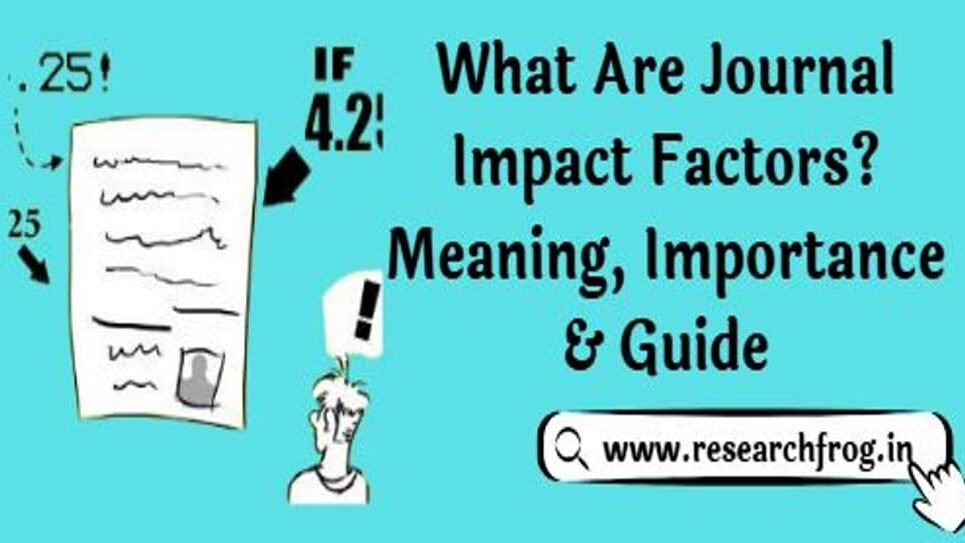What Are Journal Impact Factors: - If you're a student, researcher and academic professional, you've most likely encountered the term journal impact factor during your studies or publishing career. But what are journal impact factors, and why are they so important in the realm of academic research?
Journal impact factors are an important indicator used to assess the influence and reputation of scientific journals. Eugene Garfield, the founder of the Institute for Scientific Information (ISI), developed the notion which has since become one of the most generally recognized criteria for evaluating academic journals. Clarivate publishes these metrics annually in the Journal Citation Reports (JCR), and they are frequently evaluated when researchers decide where to publish their work.
What Are Journal Impact Factors?

The journal impact factor measures how frequently publications from a certain journal are cited over a given time period, which is typically two years. A higher impact factor often indicates that the journal's articles are more frequently referenced and so regarded to be of greater academic value.
Understanding journal impact factors enables scholars to navigate the complex world of academic publishing. Institutions, funding organizations, and universities frequently employ impact factors to assess faculty performance, allocate research money and decide on academic promotions. In today's data-driven research climate, understanding journal impact factors is not only advantageous but also necessary.
This blog post will look at how journal impact factors are determined, their benefits and drawbacks, and how to use them effectively when submitting your research to academic journals.
How Are Journal Impact Factors Calculated?
To comprehend journal impact factors, we must first consider how they are determined. The standard formula is:
Impact Factor (IF) = Citations in Current Year to Articles Published in Previous 2 Years ÷ Total Number of Articles Published in the Same 2 Years
For example, if a journal published 100 papers in the previous two years and they were cited 300 times in the current year the impact factor would be 3.0. This figure reflects the average number of citations per paper.
Why Are Journal Impact Factors Important?
Now that we've defined journal impact factors, let's talk about why they are important:
- Research Credibility: Journals with high impact factors are frequently perceived as more credible and influential.
- Career Advancement: Publishing in high-impact journals can help a researcher advance in their career and increase their chances of getting tenure.
- Funding Opportunities: Funding agencies frequently favor work published in renowned journals.
- University Rankings: Universities use the impact factors of the journals in which their faculty members publish to boost their institutional rankings.
Criticism and Limitations:
Despite their popularity, impact factors are not without problems. Critics contend that:-
- They Favor Certain Fields: Journals in the living sciences have greater impact factors than those in the humanities or social sciences.
- Citation Gaming: Some journals manipulate citations to improve their ranking.
- Not Always Reflective of Quality: A highly referenced article does not necessarily indicate good quality.
Tips for Using Impact Factors Wisely
Researchers can make effective use of impact variables in the following ways:
- Within Your Field: It is important to always evaluate the impact factors of different journals that are published within the same field. In addition to the impact factor you should check the scope of the journal to make sure that it is relevant to the subject of your research.
- Look Beyond the Number: Take into consideration the quality of the editorial board, the acceptance rate, and the procedure of peer review.
- Utilize Multiple Metrics: In addition to impact factors, you should also make use of the h-index, Eigenfactor, or SCImago Journal Rank.
FAQs
What are journal impact factors in simple terms?
Journal impact factors are numbers that show how often a journal's articles are cited in other research. A higher impact factor usually means the journal is more influential or respected in its field.
Who calculates journal impact factors?
Journal impact factors are calculated by Clarivate Analytics, and published annually in the Journal Citation Reports (JCR).
How often are journal impact factors updated?
Journal impact factors are updated once a year, typically in June, covering citation data from the previous two years.
Are high journal impact factors always better?
Not always. While high impact factors suggest a journal is widely cited, they don’t guarantee article quality. It’s important to consider peer-review standards, editorial board, and journal scope as well.
What is a good journal impact factor?
A “good” impact factor depends on the research field. For example, in medicine or life sciences, an impact factor above 5 is considered strong, whereas in social sciences, even 2 can be significant.
Conclusion
The journal impact factors are a statistic for assessing the exposure and influence of academic journals based on citation frequency. While they have a substantial influence on academic careers and research funding decisions, they are not without dispute. Understanding their calculation, relevance, and limitations is critical for any scholar who wants to make educated publishing decisions. Whether you're submitting a manuscript or selecting literature to cite, understanding journal impact factors can help you improve your scientific approach and exposure.
Also Read: - Best Research Paper Writing Services for Students in 2025


One thought on “What Are Journal Impact Factors 2025 | Meaning, Importance & Guide”